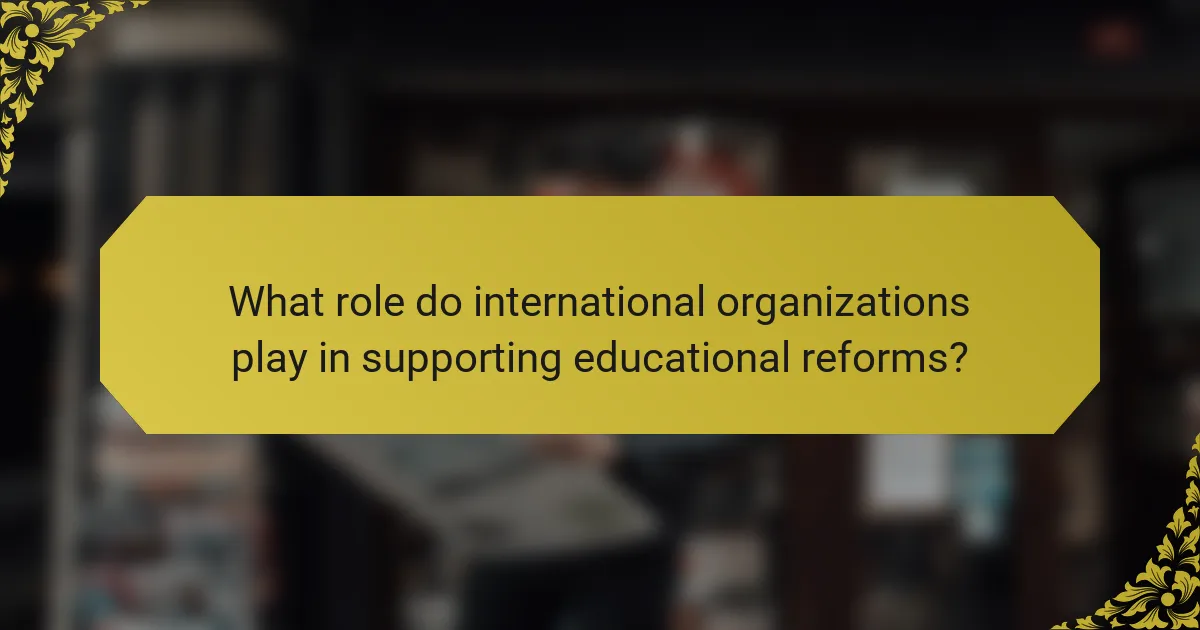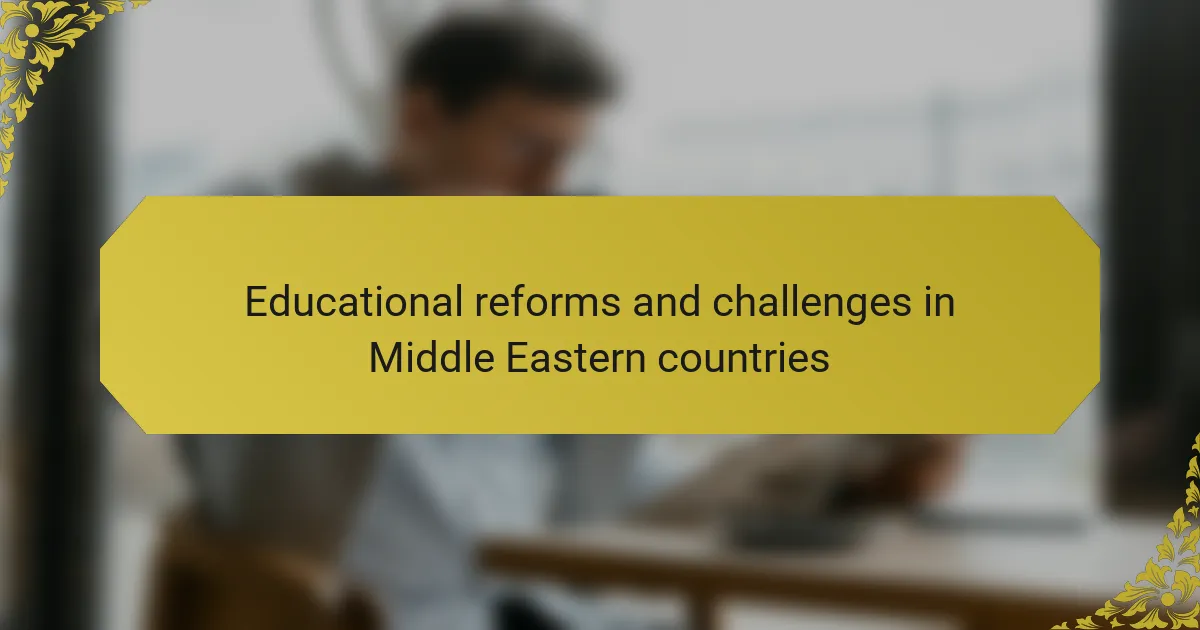
What are the key educational reforms in Middle Eastern countries?
Key educational reforms in Middle Eastern countries include curriculum modernization, increased access to education, and teacher training initiatives. Countries like Saudi Arabia and the UAE have implemented reforms to align their education systems with international standards. These reforms aim to enhance critical thinking and problem-solving skills among students. Additionally, many nations are focusing on vocational training to meet labor market demands. For instance, Egypt has introduced technical education programs to reduce youth unemployment. Investments in digital learning resources are also a significant trend. These reforms are supported by various government initiatives and international partnerships. Overall, the goal is to create a more skilled and adaptable workforce in the region.
How have historical contexts influenced educational reforms?
Historical contexts have significantly influenced educational reforms in Middle Eastern countries. Various political, social, and economic factors shape these reforms. For instance, the post-colonial era prompted many nations to reform education systems to promote national identity. The Arab Spring also led to calls for educational changes, emphasizing critical thinking and civic engagement. Additionally, economic development initiatives often prioritize education to foster workforce skills. Historical conflicts have sometimes disrupted educational systems, necessitating reforms for recovery and modernization. These contexts demonstrate how historical events and movements directly impact educational policy and practice in the region.
What role did colonial history play in shaping education systems?
Colonial history significantly influenced education systems in Middle Eastern countries. Colonial powers often imposed their own educational models. These models prioritized Western curricula and languages over indigenous knowledge. As a result, local cultures and languages were marginalized. The educational systems were designed to serve colonial interests. This included training local elites to assist in administration. Many countries retained these colonial structures post-independence. Consequently, education systems still reflect colonial legacies today. This has led to ongoing debates about curriculum relevance and cultural identity.
How have recent political changes impacted educational policies?
Recent political changes in Middle Eastern countries have significantly impacted educational policies. For instance, shifts in governance often lead to new priorities in curriculum development. Some governments have emphasized STEM education to align with economic goals. Others have focused on increasing access to education for marginalized groups. Changes in leadership can also affect funding allocations for schools. In many cases, political instability has disrupted educational continuity. Additionally, reforms may include efforts to integrate technology in classrooms. These adjustments reflect the need to adapt to both local and global educational demands.
What are the main objectives of current educational reforms?
The main objectives of current educational reforms include improving quality, accessibility, and relevance of education. Educational reforms aim to enhance student outcomes through updated curricula and teaching methods. They also focus on increasing access to education for marginalized groups. Another objective is to align education systems with labor market needs. This ensures graduates possess skills required by employers. Additionally, reforms seek to promote critical thinking and problem-solving abilities among students. They emphasize the importance of technology integration in learning environments. Lastly, fostering inclusive and equitable education is a key goal. These objectives are crucial for addressing challenges in Middle Eastern countries.
How do reforms aim to improve access to education?
Reforms aim to improve access to education by implementing policies that reduce barriers for students. These reforms often include increasing funding for schools in underserved areas. They may also focus on training teachers to better support diverse learning needs. Additionally, reforms can introduce scholarship programs to assist low-income families. Expanding school infrastructure is another key strategy to accommodate more students. Governments may also promote inclusive education practices to ensure all children can attend school. These initiatives are supported by international organizations that provide resources and expertise. For instance, UNESCO emphasizes the importance of equitable access to quality education as a fundamental human right.
What measures are being taken to enhance the quality of education?
Governments in Middle Eastern countries are implementing various measures to enhance the quality of education. These include curriculum reforms to align with international standards. Teacher training programs are being expanded to improve instructional methods. Investment in educational technology is increasing, providing students with modern learning tools. Partnerships with international educational organizations are being established to share best practices. Assessment and evaluation systems are being refined to better gauge student performance. Increased funding for schools is being prioritized to improve infrastructure and resources. Policies promoting inclusive education are being developed to support diverse learning needs. These measures aim to create a more effective and equitable education system across the region.
What challenges do Middle Eastern countries face in implementing educational reforms?
Middle Eastern countries face significant challenges in implementing educational reforms. These challenges include political instability, which disrupts consistent policy development. Economic constraints limit funding for educational initiatives. Cultural resistance often hinders the adoption of new teaching methods. Inadequate infrastructure affects the delivery of quality education. Additionally, a shortage of qualified teachers undermines reform efforts. Bureaucratic inefficiencies can slow down the implementation process. Lastly, disparities in educational access create inequalities among different regions and demographics.
How does socio-economic disparity affect educational access?
Socio-economic disparity significantly affects educational access. Individuals from lower socio-economic backgrounds often face barriers to quality education. These barriers include limited financial resources, inadequate school facilities, and a lack of access to educational materials. According to UNESCO, children from the poorest households are three times more likely to be out of school than those from wealthier families. Additionally, socio-economic status often influences parental education levels, which can impact children’s academic performance. In many Middle Eastern countries, these disparities lead to unequal opportunities, perpetuating cycles of poverty. Research by the World Bank indicates that improving educational access for disadvantaged groups can enhance overall economic growth and social development.
What are the barriers related to cultural attitudes towards education?
Barriers related to cultural attitudes towards education include traditional beliefs and gender roles. In many Middle Eastern societies, education is often viewed as less important for girls. This perspective limits female participation in educational systems. Additionally, familial expectations can prioritize early marriage over academic pursuits. Societal norms may also discourage critical thinking and questioning authority within educational settings. These cultural attitudes can lead to lower enrollment rates and higher dropout rates. According to UNESCO, the gender gap in education remains significant in several Middle Eastern countries. This gap hinders overall educational progress and reform efforts.

How do educational reforms vary across different Middle Eastern countries?
Educational reforms vary significantly across different Middle Eastern countries. Each country tailors its reforms to address specific educational challenges. For example, Saudi Arabia emphasizes STEM education to diversify its economy. In contrast, Egypt focuses on improving literacy rates and access to education. The United Arab Emirates invests heavily in technology integration in classrooms. Jordan has prioritized teacher training and curriculum development. These reforms reflect the unique socio-economic contexts and educational needs of each nation. Data from the World Bank indicates that these reforms aim to enhance educational quality and relevance in a rapidly changing global landscape.
What are the unique reforms in the Gulf Cooperation Council (GCC) countries?
The unique reforms in the Gulf Cooperation Council (GCC) countries focus on diversifying education systems. These reforms aim to improve educational quality and relevance. Countries like Saudi Arabia and the UAE have implemented curriculum updates. They emphasize STEM (Science, Technology, Engineering, and Mathematics) education. Qatar has introduced initiatives for vocational training and skill development. Bahrain has focused on enhancing teacher training programs. Oman is investing in digital education and e-learning platforms. These reforms address regional challenges and align with economic diversification goals.
How is the education system in Saudi Arabia evolving?
The education system in Saudi Arabia is evolving through significant reforms aimed at modernization. The Vision 2030 initiative emphasizes enhancing educational quality and aligning it with labor market needs. Curriculum updates are being introduced to foster critical thinking and creativity. New learning methodologies, including project-based learning, are being implemented in schools. Increased investment in vocational and technical education is a priority to diversify career pathways. Digital learning tools are being integrated to improve accessibility and engagement. International partnerships are being established to enhance educational standards. Recent statistics indicate a rise in student enrollment in higher education from 1.5 million in 2010 to over 3 million in 2022. These changes reflect a commitment to creating a more skilled workforce and a knowledge-based economy.
What innovations are being adopted in the UAE’s education sector?
The UAE’s education sector is adopting various innovations to enhance learning experiences. These include the integration of artificial intelligence in classrooms. AI is being used to personalize learning for students. Additionally, there is a focus on digital learning platforms. These platforms provide access to a wide range of resources and interactive content. The use of smart classrooms is also on the rise. Smart classrooms utilize technology to facilitate interactive and engaging lessons. Furthermore, there is an emphasis on STEM education. This initiative aims to prepare students for future job markets. The UAE government supports these innovations through funding and strategic initiatives. These efforts are part of a broader educational reform strategy aimed at improving quality and outcomes.
What are the reform strategies in non-GCC Middle Eastern countries?
Reform strategies in non-GCC Middle Eastern countries focus on improving educational systems. These strategies often include curriculum modernization, teacher training, and increased access to education. Countries like Egypt and Jordan have implemented reforms to enhance critical thinking skills. Investment in technology and infrastructure is also a key component. For example, Lebanon has introduced digital learning tools in classrooms. Additionally, partnerships with international organizations support educational initiatives. The aim is to align education with labor market needs. Overall, these strategies seek to foster economic growth and social development.
How is Egypt addressing educational challenges through reforms?
Egypt is addressing educational challenges through comprehensive reforms aimed at improving quality and accessibility. The government has implemented a new education strategy that focuses on modernizing curricula. This strategy emphasizes critical thinking and digital skills. Additionally, Egypt has increased investment in educational infrastructure. This includes building new schools and upgrading existing facilities. Teacher training programs have also been enhanced to improve teaching standards. The reforms aim to reduce class sizes and promote inclusive education. These initiatives are supported by international partnerships and funding.
What initiatives are being taken in Jordan to improve education?
Jordan is implementing several initiatives to improve education. The Ministry of Education launched the Jordan Education Reform Support Program. This program aims to enhance the quality of education and student outcomes. It focuses on curriculum development, teacher training, and school infrastructure improvements. The government is also investing in technology integration in classrooms. This includes providing digital resources and training for teachers. Additionally, Jordan is promoting inclusive education for students with disabilities. These efforts are supported by international partnerships and funding from organizations like the World Bank.

What role do international organizations play in supporting educational reforms?
International organizations play a crucial role in supporting educational reforms. They provide funding, expertise, and policy frameworks to enhance education systems. Organizations like UNESCO and the World Bank offer technical assistance to develop curricula and teacher training programs. They also facilitate knowledge sharing among countries facing similar challenges. For example, UNESCO’s Global Education Monitoring Report highlights best practices in educational reform. Furthermore, international organizations advocate for inclusive education policies that address diverse learning needs. Their involvement helps ensure that reforms align with global standards. This support is essential for improving educational outcomes in Middle Eastern countries.
How do organizations like UNESCO contribute to educational development?
Organizations like UNESCO contribute to educational development by promoting access to quality education worldwide. They provide technical assistance and resources to improve educational systems. UNESCO supports member states in developing policies for inclusive education. They also conduct research to identify effective teaching methods and curricula. Additionally, UNESCO facilitates international cooperation and knowledge sharing among countries. Their Global Education Monitoring Report tracks progress toward educational goals. UNESCO’s initiatives aim to ensure education for all, particularly in underserved regions. Their work is crucial in addressing educational challenges in Middle Eastern countries.
What programs are in place to assist Middle Eastern countries?
Various programs assist Middle Eastern countries in educational reforms. The United Nations Educational, Scientific and Cultural Organization (UNESCO) implements initiatives to enhance educational quality. The World Bank provides funding for educational projects aimed at improving access and learning outcomes. The Arab League also promotes regional cooperation in education through its various educational initiatives. Additionally, the United States Agency for International Development (USAID) supports educational programs focusing on curriculum development and teacher training. These programs collectively aim to address the challenges faced in the educational sector across the region.
How do funding initiatives impact the success of educational reforms?
Funding initiatives significantly enhance the success of educational reforms. Adequate funding allows for the development of new curricula and teaching materials. It also facilitates the training of educators to implement reforms effectively. For example, a study by the World Bank indicated that countries investing in education saw improved student outcomes. The report highlighted that increased funding led to better infrastructure and resources in schools. Additionally, targeted funding initiatives address specific needs, such as technology integration. This targeted approach can lead to higher engagement and retention rates among students. Thus, funding initiatives are crucial for the effective implementation and sustainability of educational reforms.
What best practices can be adopted from successful educational reforms globally?
Successful educational reforms globally emphasize several best practices. First, they prioritize teacher training and professional development. Evidence shows that well-trained teachers significantly improve student outcomes. Countries like Finland have invested heavily in teacher education, resulting in high student performance.
Second, successful reforms implement evidence-based curricula. Research indicates that curricula aligned with student needs lead to better engagement and learning. The Singaporean education system is known for its rigorous, research-backed curriculum.
Third, they promote inclusive education. This approach ensures that all students, regardless of background or ability, have access to quality education. For instance, Sweden’s inclusive policies have improved educational equity.
Fourth, data-driven decision-making is crucial. Successful reforms utilize data to assess student performance and inform policy changes. The United States has seen improvements in schools that regularly analyze educational data.
Lastly, community and parental involvement enhance educational success. Engaging families in the education process fosters a supportive learning environment. Studies show that schools with active parental participation report higher student achievement.
How can Middle Eastern countries learn from Finland’s education model?
Middle Eastern countries can learn from Finland’s education model by adopting its focus on equal opportunities and student well-being. Finland emphasizes a student-centered approach, which encourages individual learning paths. This model includes minimal standardized testing, allowing teachers to assess students’ progress holistically. Furthermore, Finland invests significantly in teacher education, requiring a master’s degree for educators, which enhances teaching quality.
Research indicates that Finland’s educational system promotes collaboration over competition, fostering a supportive learning environment. This approach leads to higher student engagement and satisfaction. Additionally, Finland’s commitment to lifelong learning can inspire Middle Eastern countries to prioritize continuous education and skill development.
By integrating these principles, Middle Eastern nations can potentially improve their educational outcomes and address existing challenges.
What lessons can be drawn from Singapore’s approach to education?
Singapore’s approach to education emphasizes high standards and accountability. It focuses on teacher training and continuous professional development. The country invests significantly in education, allocating about 20% of its annual budget. Rigorous curriculum frameworks ensure students meet global benchmarks. Data-driven assessments guide instructional improvements. Collaboration between schools and industries enhances relevance in education. Parental involvement is actively encouraged, fostering a supportive learning environment. These strategies contribute to Singapore’s consistent ranking among the top education systems worldwide.
What practical steps can be taken to overcome challenges in educational reforms?
Practical steps to overcome challenges in educational reforms include engaging stakeholders in the reform process. This involves teachers, parents, and community leaders in discussions. Collaborating with local and international experts can provide valuable insights. Implementing pilot programs allows for testing reforms on a smaller scale before wider application. Providing adequate training for educators is crucial for successful implementation. Establishing clear goals and metrics helps in assessing progress. Allocating sufficient funding ensures that reforms are sustainable. Lastly, fostering a culture of continuous feedback can help adapt reforms to changing needs. These steps are supported by research indicating that stakeholder engagement and proper training significantly improve educational outcomes.
The main entity of this article is educational reforms in Middle Eastern countries. The article examines key reforms such as curriculum modernization, increased access to education, and teacher training initiatives, highlighting the impact of historical contexts and recent political changes on educational policies. It discusses the objectives of current reforms, challenges faced in implementation, and the role of international organizations in supporting these initiatives. Additionally, it explores unique reform strategies across various countries in the region, including the Gulf Cooperation Council (GCC) and non-GCC nations, while identifying best practices from global educational models that can inform future developments.


